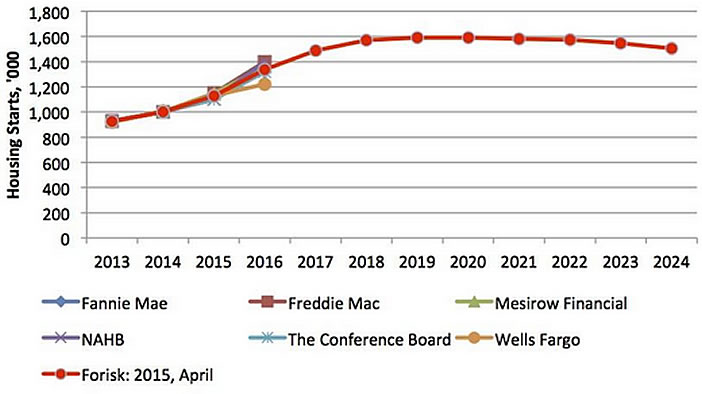Home construction drives baseline wood demand in the United States. Without demand for wood and forest products, timber and timberland values deteriorate. Without wood demand, investments in Star Trek sawmills, Jack-in-the-Beanstalk tree seedlings, and color-coordinated safety vests and snake chaps are for naught.
U.S. Housing Starts Outlook, Q2 2015 Update
Each quarter when updating our Forisk Research Quarterly forecast models, we review prior projections to learn. In 2014, total housing starts increased 7.3% over 2013. Looking forward, Forisk projects growth of 12.5% in 2015. Forisk’s Housing Starts Outlook combines independent forecasts from professionals in the housing industry. These include Fannie Mae, Freddie Mac, Mesirow Financial, the National Association of Home Builders (NAHB), The Conference Board, and Wells Fargo (Figure).

Overall, Forisk projects 2015 housing starts of 1.13 million, down 4.9% from 1.18 million as of January 2015. Forisk’s 2015 Base Case peaks at 1.59 million housing starts in 2019 before returning to a long-term trend approaching 1.51 million. For comparison, our August 2014 Base Case peaked at 1.58 million housing starts in 2019.
Softwood Lumber Production and Pine Sawtimber Prices
During “normal” economic times, the United States uses over 500 million tons of roundwood and chips per year. Each quarter, Forisk uses the housing starts projections to estimate the softwood lumber required to build those homes. Forecasting local and state-specific timber prices requires assessing where that lumber gets produced. In the United States, lumber consumers rely on three sources for 95% of their supply: the U.S. South, the Pacific Northwest, and Canadian imports. In the 1990s, the Pacific Northwest was the largest producer. In the early 2000s, Canada was the largest producer. And since 2006, the U.S. South has been the largest producer. In other words, softwood lumber production and supplies shift over time across North America.
In evaluating regional production, we test the sensitivity of our assumptions. For example, to what extent does the regional assumption related to softwood lumber production affect forecasts of pine sawtimber prices locally? Specifically, what would it mean to shift 1 billion board feet of softwood lumber production from the Pacific Northwest to the U.S. South? Let’s walk through this:
- In the South, 1 billion board feet requires ~4.5 million tons of wood, more or less, depending on the specific mill technologies and log sizes. This production would also result in another ~1.3 million tons of residual chips for pulpwood consumers.
- South wide, this level of increased wood demand lifts pine sawtimber prices by $1 to $1.25 per ton on average.
- However, in practice, this production would not be distributed evenly. It would affect each state and local market differently. Looking state-by-state, for example, this shift would lift pine sawtimber prices by $0.50 to $2.50 per ton or more.
In the end, timber markets are uniquely local. And this type of sensitivity analysis provides quantitative assessments of key assumptions driving forecasts related to capacity, timber revenues, and wood costs in specific states and wood baskets.
Brooks Mendell, Ph.D. is President and Founder of Forisk Consulting, a forest industry, timber REIT, bioenergy and timber market research firm. Dr. Mendell has over fifteen years of operating, research, and consulting experience in forest business and finance. Mendell has published over sixty articles and two books on topics related to timber and timberland REITs and markets, forest business management and operations, and communication skills.
You can view the original article published by LandThink.com here.

